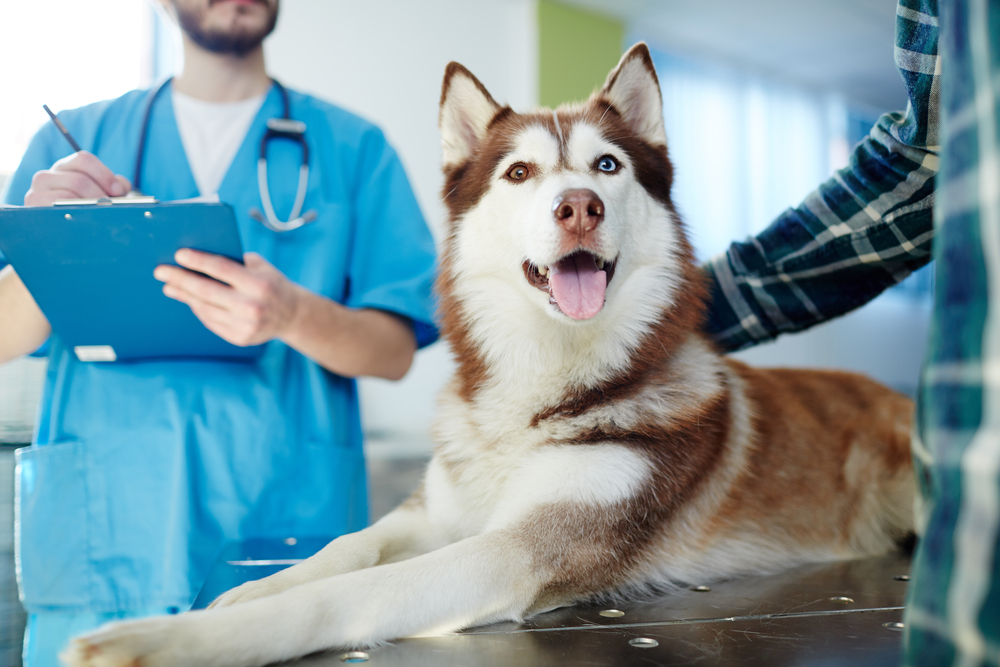Veterinary visits can be stressful for many pets, despite our attempts to make exams and treatment as comfortable as possible. In addition to the stress-free methods we use here at Animal Clinic of Council Bluffs, you can undertake a few at-home steps that will reduce your pet’s anxiety. Give the following tips a shot.
#1: Practice handling and restraining your pet
When your pet is being examined by our team, they’ll likely be put in some positions or handled in a manner they’re not accustomed to, which can ratchet up their anxiety level. Ease your pet’s fears by routinely performing your own physical exam at home, to expose your furry pal to unusual “petting.” Acclimate your pet to examination of their entire body, from nose to tail, focusing on the following sensitive areas:
- Eyes — Direct eye contact is typically seen as a threat in the animal world, and coming close to their eyes with an ophthalmoscope can be exceptionally scary for your pet. Encourage your pet to make eye contact with you by teaching the command, “Watch me.” They will most easily learn this skill if you reward them every time they look at you, and you cue them when they are consistently gazing into your eyes. Use this command when you’re close to your pet’s face, and holding their muzzle to keep their head still. Praise and reward your furry pal for a job well done.
- Ears — Many pets are sensitive about their ears being touched, but you can desensitize them to handling, and make ear infection treatment much more pleasant. Pair high value treats, such as hot dogs, spray cheese, peanut butter, or tuna, with ear manipulation. Lift up their ear flap and wipe out the folds with a gauze-covered finger, praising your pet the entire time.
- Mouth — Dental disease is the most common condition that affects pets over the age of 3, so teaching your pet to accept an oral examination is critical for good health. Work up to lifting your pet’s lips, and examining their teeth and tongue by scratching under their chin and around the muzzle. Once your pet is comfortable with their lips being lifted, you can open their mouth to check their tongue for abnormalities, or the presence of oral masses.
- Under the tail — Under the tail is especially sensitive, but many issues can lie hidden without routine examination. Pets generally enjoy being scratched on the tail head (i.e., where the tail connects to the body), and you can smoothly lift the tail, and quickly peruse underneath to check for inflammation, diarrhea evidence, masses, or other abnormalities.
- Paws — Many pets do not enjoy nail trims—in fact, many dread nail trims more than vaccinations. Ensure your pet doesn’t mind their paws being handled by touching their feet every day, and rewarding them for good behavior or offering their paw to you.
#2: Stop by our clinic for happy visits with your pet
You are naturally wary and nervous in an unfamiliar setting or a place you typically associate with unpleasant activities, and your pet likely feels the same way when they visit our clinic only for their annual checkup. Help your four-legged friend see our Animal Clinic of Council Bluffs as a wonderful place, full of treats and special attention, by dropping by regularly for happy visits. Call ahead to see when we have a slow period, and then stop by with your pet to get their favorite treats. We’ll dole out the goodies, offer belly rubs, and generally make our clinic less scary and more familiar to your furry pal.
#3: Acclimate your pet to their carrier
When you bring out your cat’s carrier once every 12 months, do they flee for safety under the couch? Your cat likely associates the carrier with leaving their territory, car rides, and veterinary visits, all of which can be frightening. So, do not bring out the carrier only for trips—instead, leave the crate out all year, with a cozy bed inside, and randomly tossed tasty treats, to encourage your cat to investigate their carrier. With time, the carrier may become their favorite place to take a snooze.
#4: Make the drive to Animal Clinic of Council Bluffs a pleasant one
Some pets have such severe motion sickness, they may vomit on their trip to our hospital, which makes the entire experience—veterinary visit included—uncomfortable and unsettling. If your pet is the sort who drools excessively, pants heavily, vomits, or becomes worked up in general when stepping paw into a vehicle, contact our veterinarian before the visit. We may prescribe anti-nausea medication to help tame your pet’s motion sickness.
In addition to reducing the nausea, increase the comfort of your vehicle’s comfort. Ensure the temperature is ideal for your pet, and provide a soft resting place where they won’t be jostled during the drive. A blanket or bed from home spritzed with a calming pheromone can help your pet relax, and make the drive more pleasant.
#5: Ask our veterinarian about anti-anxiety medication

Some pets become so anxious when visiting their veterinarian that they need anti-anxiety medication. You administer these medications, which work by taking the edge off your pet’s stress, at home, prior to leaving for your appointment. The medication may be slightly sedating, but your pet can still walk into the hospital, and they will be less anxious and more accepting of veterinary care.
If you know your furry pal is less than excited about attending their annual wellness visit, contact our Animal Clinic of Council Bluffs team for advice on stress-reducing methods, prior to their exam.






Leave A Comment